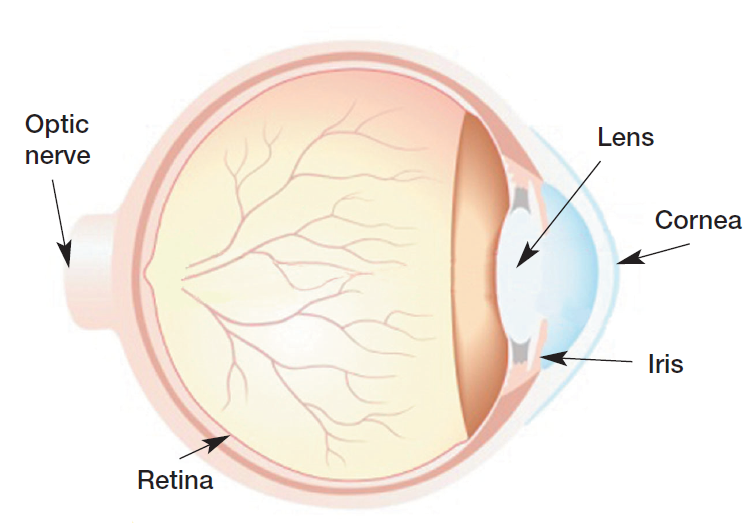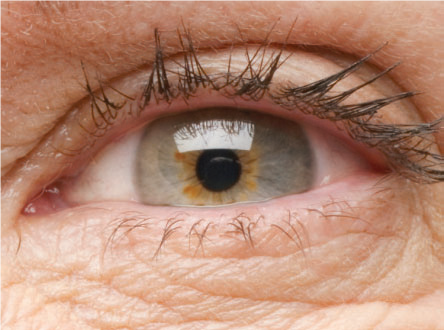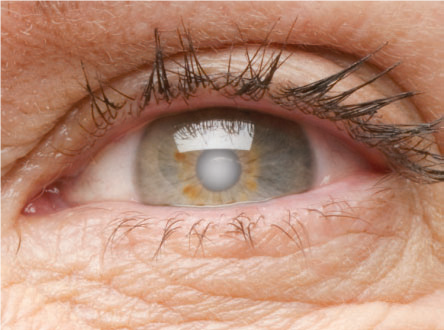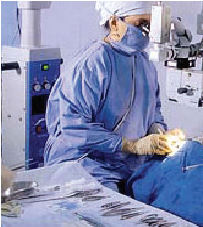WHAT IS CATARACT?
A cataract is a clouding of the lens in your eye1.
How does the eye work?
The eye is a vital organ in human body & it works much like a digital camera. In a normal eye, light passes
through the transparent cornea & crystalline lens & falls onto the retina. The retina acts like an electronic
image sensor of a digital camera, converting optical images into electronic signals. These electronic
signals are then sent to the brain. The brain interprets these signals to “see” the world around us.1,2

What is a cataract?
A cataract is a clouding of the lens in your eye1. The lens contains proteins and water which are clear in a
healthy lens. As the cataract forms, the protein clusters together, resulting in the cloudiness or frosting
of the lens. This results in dull, blurred vision which deteriorates over time.


Normal, clear lens Lens clouded by cataract
What causes a cataract?
Cataract is a natural part of ageing process, although occasionally children may be born with the
condition. Cataract may also develop after an injury, inflammation or disease in the eye. Other risk
factors associated with age-related cataract development are diabetes, prolonged exposure to sunlight,
tobacco use and alcohol consumption3.
Most people start to develop cataracts after the age of 65, but some people in their forties and fifties can also develop cataracts1.
What are the symptoms of a cataract?
The symptoms of a cataract may include4:
- Blurred, fuzzy or hazy vision
- Night vision affected by glare or halos
- Reduced vision in bright surroundings or sunlight
- Faded colour vision
- Frequent changes in eyeglass prescription
How does a cataract affect eyesight?
The cloudiness interferes with the way light passes through the lens to the back of the eye. This causes patients to have blurred vision, or possibly “see double”, color vision may be affected, or patients may experience difficulty to see in bright light. These symptoms often develop gradually over months or years.
As the cloudiness spreads across the lens, it becomes more difficult to see clearly.
How is a cataract treated?
If your vision is mildly affected, then you may be able to continue your daily routine adequately with the aid of glasses or lenses. Cataract normally become cloudier over time, resulting in severely impaired vision.
Your Ophthalmologist will advise you to undergo cataract surgery when it is the right time. The surgery involves an operation to remove the cloudy lens and replace it with a clear artificial replacement, known as an intraocular lens (IOL).
What is an intraocular lens (IOL)?
An IOL is an artificial lens which is implanted in your eye during cataract surgery as a replacement of your natural lens.
Are there any alternatives to treat cataract?
There isn’t any medicine or drops that can remove cataracts – surgery is the only way to treat them2.
Before the operation
Prior to the surgery, the cataract procedure will be explained to you and a pre-admission assessment will be performed at the hospital/center. Special tests and measurements on the eye will be performed to determine the size and power of intraocular implant (IOL) which will replace the cloudy lens. Different IOLs are available these days, so your surgeon will discuss the different choices of lenses with you. Once the procedure has been explained, you will be asked to sign a patient consent form.
Medication (drops) will be placed in your eyes to dilate your pupils, making your vision blurry for several hours, so please ensure you have someone to accompany you home1.
What happens on the day of surgery?
The cataract surgery is performed under local or topical anesthetic. Before the operation, the eye drops or injections around your eye will be given to numb the eye. You will be fully awake, but you do not need
to worry about keeping your eye open. You will not be able to see the operation, although you may be able to see light. Usually, the procedure only takes 15 to 20 minutes, including implanting the new artificial lens.
The operation is performed in an operating theatre while you are lying down on a surgical bed, with sterile surgical sheets placed around the area of the eye. The surgeon will have close-up vision of your eye using a microscope.
At the start of the procedure, the surgeon makes two small incisions on the eye’s surface, at the edge of the colored iris. The natural cataract lens is then removed using an ultrasonic technique called phaco-emulsification, with special microsurgical instruments. This procedure in painless.
The lens capsule which accommodates lens is left there and the artificial intraocular lens (IOL) is then implanted by injecting it into this capsular bag1.

After the operation
Cataract operations are performed in the out-patient clinic, so you should be able to return home on the same day post-surgery, without any overnight stay. You may have a protective pad placed on your eye which you will need to wear for several hours. You will be shown how to clean and correctly put in the eye drops before you go home. At night you may be given a plastic eye shield to wear, which will prevent you from accidentally rubbing your eye while you’re sleeping1.
Will I feel any pain?
No pain is felt as the cataract slowly develops. When the cataract is treated, patients are given a local anesthetic, so will not feel any pain during surgery. As the anesthetic wears off after the operation, you may feel a slight ache in and around the eye. The medical staff can offer advice on pain relief.
How quickly will my vision return?
Your vision should start to return a few hours after the operation and improve during the following weeks1.
Will I still need to wear glasses?
The need for glasses or changes to your glasses prescription will be affected by which intraocular lens has been implanted in your eye. Different types of intraocular lenses are available with different ways of correcting for near, intermediate and distance vision. Your surgeon will explain the different options to you prior to the surgery.
Follow-up appointments
The surgeon will arrange follow-up appointments with you to assess the improvement to your vision. You
will be able to obtain your glasses prescription between 4-8 weeks after surgery. Your surgeon will inform you when you can drive again.

Aftercare
Your surgeon will provide guidance on returning to daily pursuits and what precautions you need to take
in the days and weeks following surgery.
Do’s
- Attend follow-up appointments
- Take the prescribed medication
such as eye drops
- Wear sunglasses when you leave
hospital
- Keep soap out of eyes
|
Don’ts
- Rub eyes
- Go out in windy weather
- Lift heavy objects or
conduct strenuous activity
- Indulge in water activities
|
Potential complications
Cataract surgery is now a commonly performed, routine procedure. Your ophthalmologist would have
recommended undergoing cataract surgery as the potential advantages and improvements to vision will
be far greater than the any possible complications. However, like all surgical procedures, there are some
possible side-effects and rare, but serious complications which could cause reduced vision or blindness.
Your Ophthalmologist will be able to answer all your queries / concerns regarding the procedure.